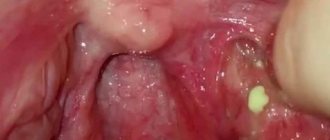Plugs in the palatine tonsils (or tonsils) are purulent accumulations in the lacunae of the tonsils. In medicine you can find other names for this pathology: purulent plugs, caseous plugs.
Most corks are white, but can have a yellow, brown or gray tint, depending on their composition.
Tonsil plugs may be soft to the touch or harder if they contain a large amount of calcium. Their size varies from a few millimeters to a centimeter. Both men and women are equally susceptible to their appearance, regardless of age.
Some patients mistakenly think that this condition does not need to be treated. But this is fundamentally wrong! The presence of purulent accumulations in the palatine tonsils contributes to the development of complications (not only in the upper respiratory tract, but even in the joints, kidneys and heart!).
Why does an accumulation of pus occur in the tonsils? How to treat tonsil plugs? And is it possible to carry out treatment at home? You will find answers to all your questions in our new article.
Laryngeal papilloma. Symptoms
Symptomatically, laryngeal papillomatosis can be represented by hoarseness, chronic cough, difficulty breathing, difficulty swallowing, recurring respiratory infections, and growth retardation in children. The presence of certain symptoms depends on the location of the papillomas. In children, the symptoms are more pronounced, since they have a significantly faster growth of papillomas, unlike adults. This can lead to situations in which emergency intervention is required for life-saving reasons, despite the histologically benign course of the disease. The prognosis is more favorable in terms of remission if the disease manifests itself in adulthood. The exception is the presence of HPV type 11 and the duration of the disease for more than 10 years.
Forms of tonsillitis
Tonsillitis (or sore throat) is an inflammation of the tonsils, often accompanies colds.
Types of sore throats
Sore throats are acute:
- Banal (vulgar or typical) tonsillitis: there are catarrhal, follicular, lacunar, mixed.
- Atypical tonsillitis: herpetic, Simanovsky-Plaut-Vincent's tonsillitis, phlegmonous, fungal and mixed forms. Usually they are severe, as they appear against the background of decreased immunity.
- Sore throats associated with infectious diseases (scarlet fever, diphtheria, sore throat due to HIV infection and others).
- Angina in blood diseases: monocytic, agranulocytic, tonsillitis in leukemia.
Tonsillitis can also be chronic (compensated and decompensated)1.
Interesting fact!
Our defense against infections is located in the pharynx - an anatomical structure consisting of lymphoid tissue. The lymphoid elements in the pharynx are located around the pharynx in the form of a ring, so it was called the “lymphadenoid pharyngeal ring” by Waldeyer-Pirogov. It is formed by two palatine tonsils (those that are sometimes called “tonsils”), one pharyngeal or nasopharyngeal (located on the back wall of the pharynx), one lingual (a collection of lymphoid follicles at the root of the tongue) and two tubal (located in the thickness of the mucous membrane of the nasopharynx near the openings eustachian tubes). Tubal tonsils are most pronounced in children under 5-7 years of age, and later undergo reverse development. In adults, due to their small size, they are almost invisible.
The pharyngeal ring is an additional barrier for bacteria between the external and internal environment of the body. These structures also produce antibodies and lymphocytes - immune response cells.
Acute tonsillitis
This is an acute inflammatory disease of the palatine tonsils. Their mucous membrane becomes swollen, hyperemic, and purulent deposits may appear in the crypts of the tonsils. But depending on the factors that caused the disease and the patient’s condition, the process is not limited to damage to the tonsils alone. A severe infection can take over the entire body. The most dangerous complications are rheumatic heart defects, joint damage, kidney damage (glomerulonephritis). Therefore, self-medication can be dangerous. For correct diagnosis and effective treatment, you need to consult a specialist.
Purulent tonsillitis is one of the forms of tonsillitis and can be a complication of acute or chronic tonsillitis. It is characterized by the presence of purulent discharge in the crypts of the palatine tonsils. Most often accompanies a bacterial infection. Improper treatment can lead to chronicity of the process.
Chronic tonsillitis is a persistent chronic inflammation of the tonsils, characterized by recurrent exacerbations in the form of tonsillitis, a sluggish course, and a decrease in the body's resistance to infection. Slight hypothermia or draft causes exacerbation of tonsillitis. Many factors play a role in the pathogenesis of chronic inflammatory process in the tonsils. Most often the disease occurs after repeated sore throats. Chronic tonsillitis is of two types: compensated and decompensated. This is important for further treatment tactics.
With compensated chronic tonsillitis, examination reveals some looseness of the tonsils, hyperemia, swelling, purulent plugs or plaque in the crypts of the tonsils, but this process is limited to the tonsils and does not spread beyond its boundaries. This precarious balance between local immunity and the body’s resistance on the one hand, and the presence of pathogenic organisms in the inflamed tonsils on the other, can shift towards decompensation if the course of the disease is unfavorable. With decompensated chronic damage to the lymphoid apparatus of the pharynx, local signs of chronic tonsillitis are usually clearly expressed. With this form, exacerbations often occur in the form of sore throats, peritonsillitis, peritonsillar abscesses, regional lymphadenitis, and in clinically advanced cases, disturbances in the functioning of other organs and systems (kidney pathology, formation of cardiac flow, articular syndrome, damage to the nervous system).
Up to contents
Causes of laryngeal papilloma. Who is at risk?
The etiological factor is human papillomavirus (HPV), in most cases types 6 and 11. The latter leads to a more severe course of the disease. Less commonly, laryngeal papillomatosis can be caused by HPV types 16 and 18, which are viruses with a high risk of developing malignant neoplasms. However, the presence of HPV in the human respiratory tract does not always lead to papillomatosis. Determining factors can be immunodeficiency states and chronic infections. Concomitant infection with the herpes simplex virus and the Epstein-Barr virus contribute to a more aggressive course of the disease.
Worrying about a cyst
“Some people are very afraid of cysts, believing that they are the same as cancer. Not everything is so simple here. Yes, one of the bad things that can be distinguished is that this is still a formation, which means that plus excess tissue means that something was not normal before, but has now appeared. The good thing is that such cysts rarely become malignant, that is, the chances that it will become cancer tend to zero,” notes the ENT specialist.
At the same time, Vladimir Zaitsev also says that against the background of such data, the cyst should not be ignored. “If you don’t treat the cyst, but come to terms with it and get used to it, then you can lead to polycystic disease, when yesterday there was one cyst, today there are two, and tomorrow a third will appear,” explains the doctor.
There should be no self-medication; there is a risk of worsening the situation with your own hands. For example, polycystic disease can develop even if a person himself decides to remove the formation. “If the cyst is removed incorrectly, for example, it is simply opened, as a result of which the cystic fluid comes out, but the membrane is preserved, then the following will happen: the membrane will collapse, the cyst will lose its tone, then it will stick into the tissue, a bridge will develop, and two cysts will appear in one place.” , notes the ENT. At the same time, you cannot climb into your throat either with improvised means or with small scalpels, which can be purchased at the same pharmacy.
Choking and skin problems. What are the consequences of the papilloma virus besides cancer? Read more
Laser removal of papilloma in the throat. Progress in medicine helps.
The main thing is to keep up with it and take advantage of all the new opportunities. In the treatment of papillomatosis, these include the use of CO2 laser, narrow-spectrum endoscopy and certain antiviral drugs. But there is one prerequisite to achieve the best result - everything must be performed by a highly qualified surgeon with extensive experience in treating laryngeal papillomatosis. This is extremely important to understand.
Papillomatosis is characterized by the formation of exophytic growths that affect the mucous membrane of various parts of the larynx and underlying parts of the respiratory tract.
More than 10 years without recurrence of papillomatosis.
All patients treated by Professor Roberto Pujedo have not experienced a relapse of the disease for more than ten years .
“A comprehensive approach is a key success factor. Starting with detailed diagnostics using cutting-edge technologies, ending with careful monitoring in the postoperative period.”
Along with the expertly performed complete removal of papillomas, Professor Roberto Pujedo carries out targeted administration of antiviral drugs into the mucous membrane of the affected areas of the larynx.
Reliable source:
Enhanced contact endoscopy (ECE) in head and neck surgery
Many patients talk about dozens of surgeries in their history and endless relapses. It seems that it is impossible to cope with this disease. Each time the voice becomes worse, numerous scars form in the larynx.
Now this is history!
Classification
Experts distinguish two types of tonsil cysts:
- Retention - formed after blockage of the ducts of the glands of lymphoid tissue, have a classic round shape, a thin capsule, filled with serous or purulent secretion. After emptying (evacuation of contents or spontaneous breakthrough), they are filled again.
- Dermoid or congenital - formed during intrauterine development, inclusions of embryonic tissue are always found in them. These true tumors, caused by genetic causes or harm suffered by the mother during pregnancy, are very rare. The capsule is usually dense and the contents are viscous.
Possible methods of treating laryngeal papillomas.
Careful removal of papillomatous growths under a microscope and using a CO2 laser is fundamental. However, removal must be carried out exclusively within the mucous membrane, where the formations are located. Moreover, the normal mucosa must be preserved. The surgeon must be experienced and thoroughly understand the mechanism of papillomas formation. Otherwise, gross surgical intervention leads to loss of voice, severe scarring, and stenosis.
Studies have shown that intraepithelial administration of antiviral drugs can reduce the number of operations to remove papillomas, leading to partial regression of the growth of formations. Also, local administration of an antiviral drug avoids systemic toxicity.
The mechanism of action of interferons in laryngeal papillomatosis is unknown, however, they are often used as an additional treatment. Interferons are naturally produced by white blood cells in response to various stimuli, including viral infection. They bind to specific cell membrane receptors and change metabolism, providing antiviral, antiproliferative and immunomodulatory effects. The clinical effectiveness of interferons in the treatment of laryngeal papillomatosis is ambiguous and controversial. The main limitation for their use are side effects when administered intravenously: increased levels of transaminases in the blood, leukopenia, thrombocytopenia. Patients may experience weakness, nausea, fever, arthralgia, and headache.
Indol-3-carbinol can be extracted from cruciferous plants (broccoli, cabbage). In vitro studies have shown promising results on the growth of papillomas by influencing estrogen metabolism. When administered orally to a small number of pediatric patients, no adverse effects were observed. However, the clinical effectiveness of this drug remains in doubt.
Measles, mumps, rubella (MMR) vaccine . A prospective randomized controlled trial showed that intraepithelial administration of MMR vaccine could prolong the period of remission after surgical treatment.
HspE7. A new vaccine targeting oncogenic HPV types has also been used to successfully control relapses of laryngeal papillomatosis.
The presence of GERD was associated with an increased likelihood of complications. The irritating effect on the mucous membrane can act as a trigger for the proliferation and spread of papillomatous growths. Studies have shown that the use of drugs to treat GERD promotes better control of laryngeal papillomatosis and prolongs remission.
According to a Cochrane review, photodynamic therapy has not been shown to be effective in the treatment of laryngeal papillomatosis.
Watch the video BEFORE/AFTER surgery to remove laryngeal papillomatosis
Relapse-free postoperative follow-up for a year. Endoscopy in NBI mode. Credit: Professor Roberto Pujedo.
Look at the photos BEFORE/AFTER the operation by Prof. Roberto Pugedu
Photos “before” and “after” surgery to remove laryngeal papillomatosis. Credit: Professor Roberto Pujedo.
Move the slider to see the difference.
Symptoms
Small accumulations, as a rule, do not cause significant symptoms. With large accumulations, the patient may experience the following symptoms of inflammation:
- bad breath;
- whitish dots are clearly visible on the surface of the tonsils;
- persistent sore throat;
- pain while swallowing;
- body temperature may be increased to 37-37.7 degrees;
- a feeling of discomfort at the site of accumulation of purulent masses;
- swollen tonsils;
- weakness, lethargy, general malaise;
- decreased performance;
- loss of appetite;
- enlarged lymph nodes;
- pain may radiate to the ears.
Traffic jams appear gradually, so in the early stages of the disease the patient experiences only discomfort when swallowing and a sore throat.
This condition is extremely dangerous for pregnant women! In addition to the fact that it has a detrimental effect on the general condition of the expectant mother, it can negatively affect the development of the fetus and, in the worst case, provoke a miscarriage. Therefore, it is extremely important to contact an otolaryngologist in time to receive competent recommendations on how to effectively treat tonsillitis during pregnancy and avoid complications.










